
Fr: Mouette des brumes
Ang: Red-legged Kittiwake
All: Klippenmöwe
Esp: Gaviota Piquicorta
Ita: Gabbiano zamperosse
Nd: Roodpootdrieteenmeeuw
Sd: beringmås
Photographers:
Ken Havard
My Bird Gallery & Flickr gallery 1 & Flickr gallery 2
Tom Merigan
Tom Merigan’s Photo Galleries
Otto Plantema
Trips around the world
Text by Nicole Bouglouan
Sources:
HANDBOOK OF THE BIRDS OF THE WORLD Vol 3 by Josep del Hoyo-Andrew Elliott-Jordi Sargatal - Lynx Edicions - ISBN: 8487334202
Bird Web (Seattle Audubon Society)
Wikipedia, the free encyclopaedia
What Bird-The ultimate Bird Guide (Mitchell Waite)
Alaska Department of Fish and Game
Red-legged Kittiwake foraging ecology by Rachael A. Orben
Trends in populations of Red-legged Kittiwake Rissa brevirostris, a Bering Sea endemic
SORA - Red-legged Kittiwake colonies in the Aleutian Islands, Alaska
Copulatory behaviour of the cliff-nesting Red-legged Kittiwake
Red-legged Kittiwake
Rissa brevirostris
Charadriiformes Order – Laridae Family
INTRODUCTION:
The Red-legged Kittiwake is endemic to the Bering Sea and breeds in several islands off Alaskan coasts, but it spends the winter at sea.
Very similar to the Black-legged Kittiwake, the present species has red legs giving the bird its name. It feeds on fish, squid, crustaceans and marine invertebrates, and nests on cliff ledges where colonies are established.
After breeding, it leaves the colonies in September and spends the winter in the NE Pacific Ocean and in the Gulf of Alaska.
The population of the Red-legged Kittiwake is threatened by reduction in food supply. Commercial fishing, but also climate change and rising of sea temperatures may have contributed to declines. The species is currently listed as Vulnerable.

DESCRIPTION OF THE BIRD:
Biometrics:
Length: 36-38 cm
Wingspan: 90 cm
Weight: 340-450 g
The Red-legged Kittiwake adult in breeding plumage is white with grey mantle, back and upperwing. The wingtips are black. We can see a white trailing edge. The tail is white.
The underparts are white, except the grey underwing and the black wingtips.
The head is white.
The bill is yellow, shorter and paler than Black-legged Kittiwake. The eyes are dark brown, surrounded by narrow, red eyering. Legs and webbed feet are red, usually bright orange to scarlet. The claws are black.
Male and female are similar.
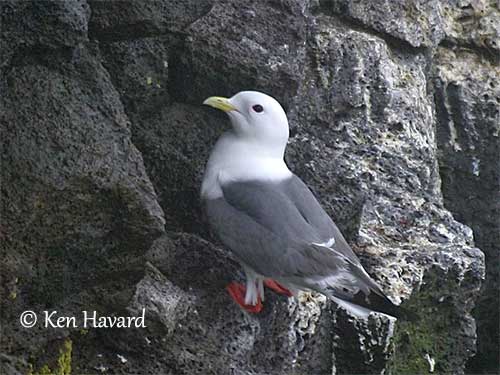
The non-breeding adult shows some dark grey markings on head and neck.
Juvenile and immature show a larger black area on the outer primaries, whereas inner primaries and secondaries are white. We can see a dark nuchal collar.
RANGE:
The Red-legged Kittiwake can be found in the Bering Sea. It breeds in Commander Islands, Pribilof Islands and Aleutian Islands. After breeding, it spends the winter at sea over N Pacific.
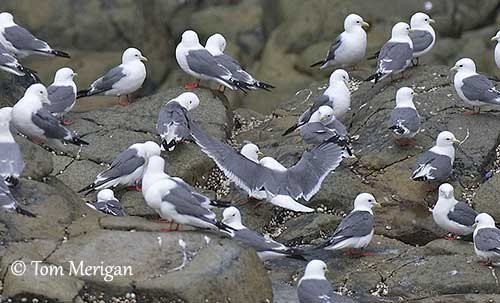
HABITAT:
The Red-legged Kittiwake breeds on islands and establishes the colonies on rocky coastal cliffs. The nests are built on ledges above the sea.
At sea, it usually prefers deep water and occurs at and beyond the edge of the continental shelf. During winter, it is sometimes very far from land in N Pacific, or near the edge of the pack ice in Bering Sea.
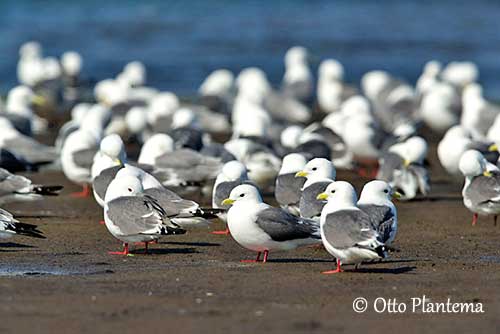
CALLS AND SONGS: SOUNDS BY XENO-CANTO
The Red-legged Kittiwake has higher-pitched calls than the Black-legged Kittiwake. It often gives a high, repeated squeal “suWEEEEr”
BEHAVIOUR IN THE WILD:
The Red-legged Kittiwake feeds on fish of several species (Notolychnus valdiviae, Pollachius pollachius), squid, small crustaceans such as amphipods, and various marine invertebrates.
It forages by day and by night, usually over deep water where it benefits from upwellings along the continental shelf. It forages by hovering briefly above the prey, before dipping down to catch it. It also feeds by pursuit-plunging. The dense schools of fish attract large foraging groups.
The large eyes of the Red-legged Kittiwake could be an adaptation to feeding in dim light.
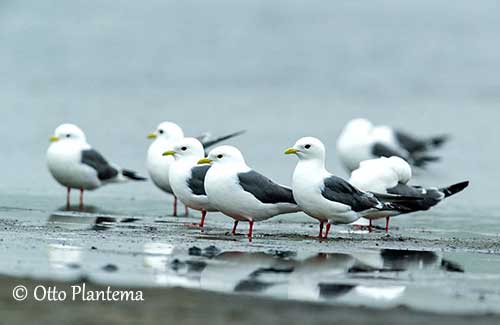
During the breeding season, this species breeds in colonies on cliff ledges. A small territory around the nest is defended by both mates.
The displays occur at nest. The birds walk slowly while bobbing the head and courtship feeding by male to female is common. The copulation occurs on the narrow ledge. The male holds the neck of the female with the bill while mating, probably to keep the balance. Both adults share the nesting duties.
The Red-legged Kittiwake usually winters at sea in N Pacific Ocean and Gulf of Alaska. It also can be found near the edge of the pack ice in the Bering Sea.
The flight is graceful and buoyant, with rapid, shallow wingbeats.
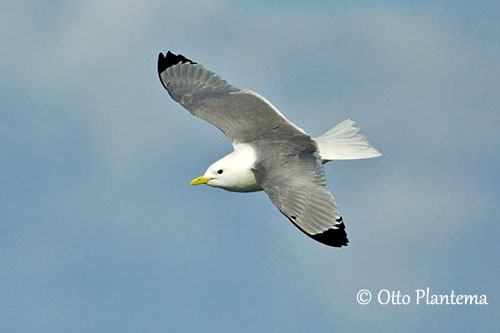
REPRODUCTION OF THIS SPECIES:
The breeding season starts in April/May, with nest-building in May. The laying occurs between mid-June and mid-July.
The Red-legged Kittiwake often breeds in mixed-species colonies with other seabirds, including the Black-legged Kittiwake. The nests are about 50 centimetres apart.
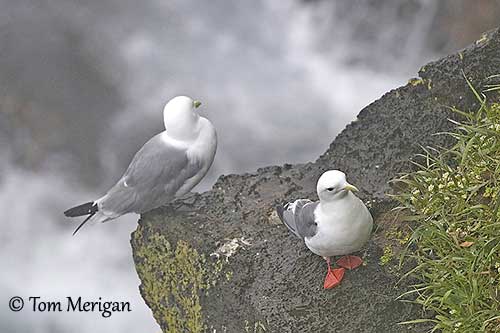
On the left (black legs)
It is a platform with a shallow cup, made with mud and vegetation. It is placed on narrow, rocky ledge above the sea. The same nest-site may be reused in several following years, or rebuilt after winter storms.
The female lays 1-2 grey, buff or greenish eggs with brown markings. Both adults incubate during 30 days (25-32 days).
At hatching, the downy chicks have white head and underparts, and brownish to grey back. They are brooded during the first two weeks. Both parents feed them by regurgitation. The young fledge 37 days after hatching, but they often return to the nest to be fed for several more days.
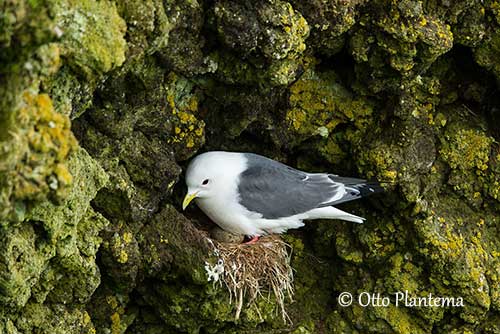
PROTECTION / THREATS / STATUS:
The Red-legged Kittiwake is affected by reduction in food supply caused by intensive commercial fishing, climate change and rising sea temperatures. In addition, large gulls, raptors, rats, foxes and humans threaten the species in the wild.
The global population is estimated to number 279,600 mature individuals, and placed in the band 100,000/499,999 mature individuals. After a rapid decline this population is suspected to have now recovered and stabilised.
But currently, the Red-legged Kittiwake is listed as Vulnerable.